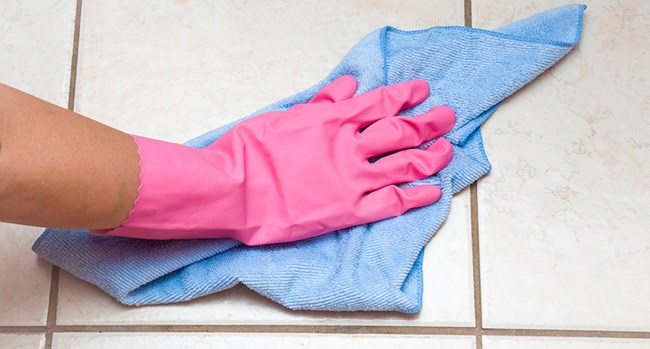Last updated: April 18, 2023
Article
Norovirus Response and Cleanup

Image/CDC
Clean and disinfect
• Limit the number of people involved in clean-up.
• Require Personal Protective Equipment (PPE) for responders: disposable gloves, facemasks with eye protection, shoe covers, and disposable gowns can all provide protection.
• Make cleaning supplies easily accessible (e.g. disposable paper towels, a bucket, a spray bottle, a designated mop head or disposable mop heads, plastic garbage bags and bag-ties, and optional disposable scoops, small shovels, dustpans, sand or cat litter, or commercial absorbent powder).
• Clean and disinfect areas within a 25-foot radius of a vomiting or diarrhea incident.
• Clean up visible debris after a vomiting or diarrhea incident with disposable absorbent materials and discard them.
• Disinfect the area within at least a 25-foot radius as well as any items/containers people might have touched while sick (such as ice buckets).
• Use a chlorine bleach solution with a concentration of 1,000 ppm to 5,000 ppm and change/remake the solution daily to maintain disinfectant properties.
| Recommended Bleach Solutions to Inactivate Norovirus | ||
| % Bleach | Amount of Bleach to Add to 1 Gallon of Water to Achieve 1,000 ppm (mg/L) Solution (Tablespoons) | Amount of Bleach to Add to 1 Gallon of Water to Achieve 5,000 ppm (mg/L) Solution (Tablespoons) |
| 5.25 | 4.9 | 24.4 |
| 8.25 | 3.1 | 15.5 |
| 12.5 | 2.0 | 10.2 |
• If chlorine cannot be used, other disinfectants registered as effective against norovirus by the Environmental Protection Agency may be used (https://www.epa.gov/sites/production/files/2016-06/documents/list_g_norovirus.pdf). Avoid products containing phenolic compounds (including triclosan and quarternary ammonium compounds), as these are less effective against norovirus.
• Consider steam cleaning soft furnishings (e.g. rugs, carpets, chairs) that are adversely affected by bleach.
• Promptly wash any linens (including clothes, towels, tablecloths, napkins) soiled to any extent with vomit or feces and dry them at highest temperature possible.
• Disinfect all equipment used in the cleanup, and wash your hands!
Avoid cross contamination
• Clean and disinfect from unaffected areas to affected areas and from low-contamination
areas to high-contamination areas.
• Keep cleaning products separate; for example, do not use one cloth for both bathroom
surfaces and ice buckets.
• Discard or disinfect all materials used in a clean-up.
Enhance routine cleaning
• Daily, use a recommended disinfectant on the entire premises.
• Hourly, use a recommended disinfectant on frequently handled items, including:
• Guest rooms: phones, chair backs, tables, balcony rails, ice buckets, glasses
• Lobbies: door knobs, courtesy phones, service counters, kiosks, chair backs, tables, cup
holders, stair rails, ice machines, drinking fountains
• Restaurants: bar rails, chair backs, tables
• Restrooms: toilets, toilet handles, sinks, faucet handles, doorknobs
• Lobbies: door knobs, courtesy phones, service counters, kiosks, chair backs, tables, cup
holders, stair rails, ice machines, drinking fountains
• Restaurants: bar rails, chair backs, tables
• Restrooms: toilets, toilet handles, sinks, faucet handles, doorknobs
Encourage handwashing
• Remind everyone to regularly wash their hands with soap and water, especially after using the
toilet and changing diapers and always before eating, preparing, or handling food.
• Install reminders, especially in restrooms, for people to wash their hands. Resources for promoting
handwashing (including posters and fact sheets) are available at www.cdc.gov/handwashing/
resources.html
Prevent person-to-person transmission
• Provide education about norovirus infection and the ways to prevent its spread.
• Encourage people with symptoms (including nausea, vomiting, or diarrhea) to stay away from
others. Sick employees, especially those involved in food handling or child-care, should remain
off duty for at least 48 hours after vomiting or diarrhea end.
• Recommend limited contact between people during an outbreak, even among those who appear
healthy.
• During an outbreak, notify your NPS Office of Public Health Officer daily with the number of people
with gastrointestinal illness as well as the number of rooms associated with illness.
Pay special attention to food preparation and food service
• Promote vigilant handwashing efforts for everyone.
• Wash fruits and vegetables and cook seafood thoroughly.
• Enforce strict glove use in conjunction with utensils policy for ALL food handlers -- no bare hand
contact should occur with ready-to-eat foods.
• Sick employees should stay home for at least 48 hours after their symptoms have resolved.
• During an outbreak, suspend all self-service food activities, such as buffets, for both employees
and visitors.
